#ImportantScottishDays
Text
Cat-Sìth | Scottish Folklore
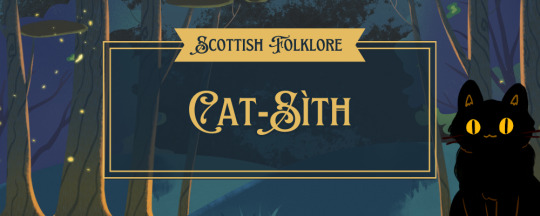
If you have ever wondered why black cats are associated with Halloween, the cat-sìth/cait-sìth may be the reason.
They are described as giant black cats with a spot on their chests, an arched back, and long hair always standing upright and bristly.
“Elfin cats (cait shìth) are explained to be of a wild, not a domesticated, breed, to be as large as dogs, of a black colour, with a white spot on the breast, and to have arched backs and erect bristles”
“Superstitions of the Highlands & Islands of Scotland” by John Gregorson Campbell (1900)

On Samhain(the early version of Halloween), when the cat-sìth was said to roam around, many families would leave out a bowl of milk to keep in the cat-sìth‘s good favour. If you did that, you would be blessed, if you forgot, you would be cursed.
As well as that, some people in the Scottish highlands were often fearful of the cat-sìth stealing the souls of the recently dead and carrying them away to the otherworld, so people would stand watch over their loved one until they could be buried. This was called Feil Fadalach or Late Wake. Essentially, this involved a large number of activities to distract the cat-sìth, such as games, dancing, contests, riddles, and even catnip spread over the house. All the fires in the room with the body would be put out, since cats like warmth (though this would also help keep the body from decomposing as quickly).
Eventually, a change of beliefs changed the cat-sìth from a fairy, into a witch. The myth that cats have nine lives is said to come from the fact that a witch could transform to a cat exactly 8 times. If she did it a 9th time, she would be a cat forever.
High-landers commonly explained the cat síth as a transformed witch, not a fairy.
A Dictionary of Celtic Mythology
The cat-sìth is not to be confused with Big Ears, the demonic god of the cats. He was said to be even bigger and more ferocious.
“But Big Ears was a monstrous demon cat who had only a slight connection with the Cait Sith.”
“A Encyclopedia of Fairies” by Katharine Briggs (Published in 1976)
That is a story I won’t be covering, because I think it will be too troubling for people. Putting it bluntly, there was a belief that if you brutally tortured a certain number of cats to death in a certain way(known as the taghairm), Big Ears would appear, and grant you wishes in return for your soul.
#caitsith#cait sith#cat sith#catsith#fairycat#fairy cat#halloween cat#samhain#folklore#scottish myths#scottish folklore#scottishfolklore#scottish mythology#scottish#scotland#halloween#ImportantScottishDays#MiscScottishFairies
52 notes
·
View notes
Text
Fairies, Turnips, and Ghost; oh my~!

During Samhuinn, while the veil is at its absolute thinnest, even the dead are said to walk with us. That lead to traditions, such as mumming and guising, but also carving turnips. That’s right, turnips.
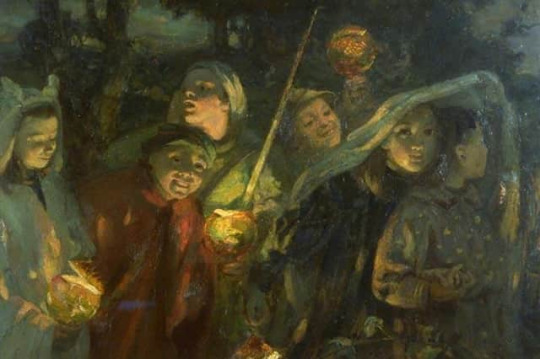
Neep lanterns. PIC: John Gray Centre, Haddington
While pumpkins might be the star of the show now, historically, it was turnips. Of course, they are much harder to carve, so it is no wonder that they were replaced. Turnips were carefully carved, lit with a candle, and carried about. These were called “neep lanterns.”
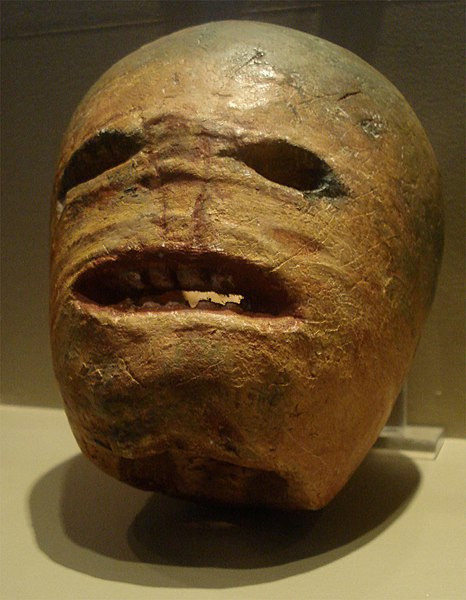
A traditional Irish turnip Jack-o’-lantern from the early 20th century. Photographed at the Museum of Country Life, Ireland.
It was not all scary, however. This was also the time to be visited by missed loved ones, so people would welcome them in with a warm fire, and food a drink just for them.
"All over Europe, the souls of the departed were believed to revisit their old homes on the eve of Allhallows and warm themselves at the fire or regale themselves with the food and drink left out for them by their kinsfolk."
The Silver Bough: Volume 1 by F. Marian McNeill (1957-1968)
Also out and about, however, were fairies, and they showed themselves in all sorts of ways.
"Mysterious lights, that have no apparent association with future events, are said to be seen periodically at certain places. One such light, it is said, appears on the Beacon Rock at the entrance of Loch Toscaig, in Applecross, on Hallowe’en night, and has done so from time immemorial."
"Folk-Lore from the West of Ross-shire" By Rev. C. Robertson(1905)
An example of this is the story of the man and the fairy mound that was once told all over Scotland with various tiny changes. I will do my best to merge them in this brief overview.
Two men are on their way home at night on Halloween when they see a dwelling open with warm lights, music, and dancing within. Without any hesitation, one of the men strides right on in to join in with the fun, while the other is suspicious. During his hesitation, the door closes, trapping his friend inside.
Because of the mysterious circumstances, everyone put the blame on him for his friends disappearance, and even suggested murder.
A whole year passed by, and when Halloween came again, there was his friend, still dancing, though, half-dead with fatigue. To save him, the young man puts an iron needle in the door, which will kept the magic from closing it on him, and stepped in to rescue his friend. Despite his state, the friend begged to keep dancing until the song was done.
When he was dragged outside, he was only skin and bone.

“I had mind it was Halloween . . . the wee callans were at it already, rinning aboot wi’ their fause-faces on and their bits o’ turnip lanthrons in their haun.”
Ayr. 1890 J. Service Notandums 40
#halloween#samhuin#pumpkins#carving#history#ScottishFolklore#scottish folklore#Samhuinn#ImportantScottishDays
31 notes
·
View notes
Text
Historic Halloween ( Samhuinn/Samhain): The Basics
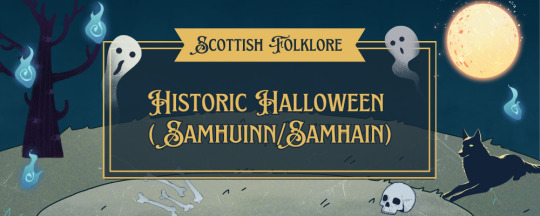
Samhuinn or Samhain are both words to describe the fire festival that predated what we now call Halloween. While I will say that it most likely started in Ireland, it is worth noting that Scotland and Ireland have a long history of trading folklore and customs(which is no surprise seeing how close the two countries are), and Samhuin is no exception.
"Of the whole series of annual festivals, Hallowe’en forms the most important occasion in the Highlands of Scotland."
“The Popular Superstitions and Festive Amusements of the Highlanders of Scotland” by William Grant Stewart (1858)
During Samhuinn and the other three major historic festivals, the veil betewen the Otherworld and our own is said to be at its thinnest, but it is even more so on Samhuinn.
This not only made it so more dead and fairies roamed, but also made saining (cleansing) rituals stronger. For Samhuin, the main focus was on fire.
"All fires were extinguished in the home and on the farm. Then the Hallow fires were kindled, very similar to those of Beltane, but more important, as heralding the advent of a new year. From the consecrated pile, portions of fire were carried to the houses to renew the flames upon the domestic hearth."
“Primitive Beliefs in the North-East of Scotland” by Joseph McKenzie McPherson (1929)
This would all start by putting out all the fires in the homes, and carrying torches about the fields and villages in a sunwise direction, to encourage good luck and good crops. When the torches were brought home, they would be collected into a bonfire.
The fires (according to Witchcraft & Second Sight in The Highlands and Islands of Scotland, and the Book of Halloween) were called Samhnagan, and there was one for each house. The houses would compete to see who could have the biggest fire, and whole districts would twinkle with bonfires.
"The motive behind the Samhain fires was the same as in. spired the Beltane festival. It was man’s response to, and attack upon, the powers of darkness. At this season, the day was shortening, the sun’s strength was diminishing, malevolent powers of every kind seemed to be abroad."
“Primitive Beliefs in the North-East of Scotland” by Joseph McKenzie McPherson (1929)
This festival lasted as so in Scotland for a long time, even as they stopped elsewhere.
"The November Eve fires which in Ireland either died out or were replaced by candles were continued in Scotland. In Buchan, where was the altar-source of the Samhain fire, bonfires were lighted on hilltops in the eighteenth century; and in Moray the idea of fires of thanksgiving for harvest was kept to as late as 1866."
“The Book of Hallowe’en” by Ruth Edna Kelley, A. M. (1919)
A common theme to all the quarter days were bannocks. For Halloween, the bannock was sometimes made with fortune telling in mind.
"The bonnach Bride, or bannock of the bride, was baked for the spring festival, the bonnach Bealltain, or Beltane bannock, for the summer festival; the bannach Lunastain, or Lammas bannock, for the autumn festival; and the bannach Samhthain, or Hallowmas Bannock, for the winter festival."
“The Silver Bough: Volume 1” by F. Marian McNeill (1957-1968)
This is the start of my series breaking down Samhuinn in Scotland. Coming up: guising, turnips, predicting the future, the returning dead, and more.
#Samhuinn#Samhain#halloween#scotland#crossquarterday#quarterday#folklore#scottishfolktales#scottish#scottish mythology#scottish folklore#scottishfolklore#ImportantScottishDays
22 notes
·
View notes
Text
Scottish Historical Lúnasdal & Lammas
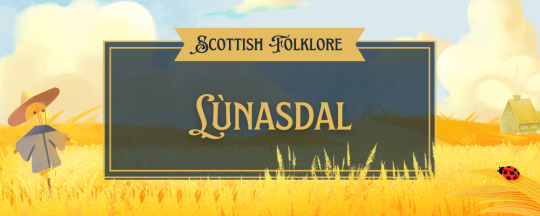
There are many theories of where the name Lammas comes from. Some I have come across are:
It could be warped from luna agustalis, which is latin for “August moon.”
It is from “loaf-mass,” which is an alternative name that some people do call it today.
It is an anglicization of Gŵyl Awst, Welsh for “feast of August”
It comes from the Anglo-Saxon “Hlâf-mæsse” which means “loaf mass.”
Lammas is mentioned as a Christian festival, but it does overlap with a pagan one. As like with other cross-quarter day festivals that coincided with church ones, the names and traditions blurred.
Lúnasdal (which has many alternative spellings), is thought to be named after the Irish god Lugh, and the day was once widely celebrated in Scotland and elsewhere. It commonly marked the end of the fishing season, and the start of the harvest season. The day would often see markets, feasts, dancing, and saining.
“This, being a quarter day, formed a great day with old women for saining cattle, and performing those ceremonies by which evil was to be kept away from them for the next three months. Tar was put on their tails and ears, charms (òradh) were said at their udders, red and blue threads were put on their tails, and various observances were gone through with balls of hair (rolag), plants, fire about the earthenware pipkins (crogain) in which milk or butter was to be put, etc. Curds and butter were specially prepared for a great feast held this day, at which it was highly important that everyone got as much as he cared for.”
“Witchcraft & Second Sight in The Highlands and Islands of Scotland” by John Gregorson Campbell (1902)
One of the most unique traditions involved a mock-war. Hundreds or more communities of a district would build towers of sod or stone.
“It was for the most part square, about 4 feet in diameter at the bottom, and tapering to a point at the top, which was seldom above 7 feet or eight feet from the ground . In building it a hole was left in the centre for admitting a flagstaff, on which were displayed their colours on the great day of the festival. This tower was generally commenced about a month before Lammas, being seldom entirely completed till close that time.”
“Old Scottish Customs, Local and General” by Ellen Emma Guthrie (1885)
As Lammas drew near, the groups would gradually build the tower, fend off any saboteurs, pick a captain, then find themselves a flag (colours) that would be put up in the tower.
For this purpose they borrowed a fine table – napkin of the largest size from one of the farmers ‘ wives within the district , and ornamented it with ribbons.
“British Popular Customs, Present and Past; Illustrating the Social and Domestic” by T. F. Thiselton-Dyer (1911)
On Lammas itself, they would set out with cudgels(a bat-like weapon), and protect their tower by any means possible, even if it included bloodshed. Some would set out, with the goal of toppling enemy towers. If the attacked stopped by mid-day, flags would be removed, and the crowds would head back to their communities while blowing horns. From then, races and other fin would be held.
For a strange bit of folklore, Lammas was said to take an eye of gadflies(horseflies), making them less dangerous.
"On Lammas day, the gad-fly “loses one of its eyes” (Latha Lùnasdal caillidh chreithleag an leth shùil). The creature is not so vicious after this date.’"
“Witchcraft & Second Sight in The Highlands and Islands of Scotland” by John Gregorson Campbell (1902)
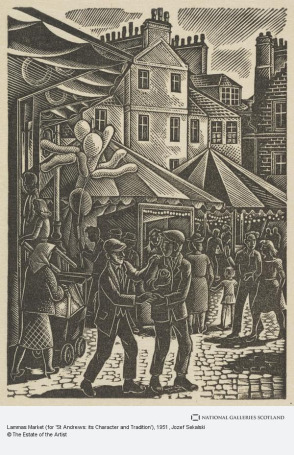
Lammas Market (for ‘St Andrews: its Character and Tradition’)
Note: if you want to do more research, there are more quotes and audio recordings on my website.
#cross quarter day#cross quarter days#folklore#history#scottish history#lammas#Lúnasdal#lughnasadh#scottish#scottish folklore#Festivals#Scottish Gods#Scottish paganism#ImportantScottishDays
21 notes
·
View notes
Text
Scottish Historical Beltane/May Day

Bealtiunn (Beltane) is a cross-quarter day, meaning it is approximately half-way between a equinox and solstice. Due to this, it was one of the four main fire festivals of the year, and a time when the veil between our world and the otherworld was said to thin. This was thought to allow fairies in particular to be extra dangerous.
"The first–called “Beltaine” in Ireland, “Bealtiunn” in Scotland, “Shenn da Boaldyn” in the Isle of Man, and “Galan-Mai” (the Calends of May) in Wales–celebrates the waking of the earth from her winter sleep, and the renewal of warmth, life, and vegetation. "
Celtic Myth and Legend by Charles Squire[1905]
It was once a huge celebration that may even last a whole week, but it also served as a marker for when to start farming practices. For example, it marked when to sow barley, or put cattle out to graze.
Due to the pagan origins of the day, opposition towards May Day celebrations was not uncommon, and eventually led to it’s fall in popularity.
"In 1696 a number of persons were tried before the Kirk Session of Aberdeen and censured for celebrating May Day morning."
Primitive Beliefs in the North-East of Scotland
For customs click "keep reading." ⬇

May Pole

May Poles are a pole that was raised on beltane and raised with a crown of flowers on the top.
“The May Pole is up ,
Now give me the cup,
I’ll drink to the garlands around it,
But first unto those
Whose hands did compose
The glory of flowers that crown’d it.”
“Faiths and Folklore: Volume 2,” By William Carew Hazlitt (1905)
It was also often decorated with flowers, leafy garland, ribbons, and more. Thought to be a fertility symbolism, with it came the queen and king of May.
"We may infer,’ says Frazer, ‘that our rude forefathers personified the powers of vegetation as male and female and attempted, on the principle of homeopathic or sympathetic magic, to quicken the growth of trees and plants by representing the marriage of the sylvan deities in the persons of a King and Queen of May, a Whitsun Bridegroom and Bride, and so forth. Such representations… were charms intended to make the woods to grow green, the fresh grass to sprout, and the flowers to blow. And it was natural to suppose that the more closely the mock marriage of the leaf-clad or flower-clad mummers aped the real marriage of the woodland sprites, the more effective would be the charm."
Silver Bough 2 By F. Marian McNeill

Dressing the Home
Due to the veil being thinner, all sorts of supernatural dangers were thought to be at play. To counteract that, people dressed their homes in flowers, greenery, and other decorations.
“To counteract their evil power pieces of the rowan-tree and woodbine, chiefly of rowan-tree, were placed over the byre doors, and fires were kindled by every farmer and cottar. “
“Notes on The Folk-Lore of the North-East of Scotland,” By Walter Gregor (1881)
It was not just leafy garlands, however, but flowers as well.
"In the country west of Glasgow it is still remembered how once the houses were adorned with flowers and branches on the first of May”
“Essays in the study of Folk-Songs,” by Countess Martinengo-Cesaresco (1886)

May-Dew
The very first thing many girls wanted to do in the morning was race out to collect the morning dew.
“COUNTY OF EDINBURGH. At Edinburgh about four o’clock in the morning there is an unusual stir ; and a hurrying of gay throngs through the King’s Park to Arthur’s Seat to collect the May-dew.”
“British Popular Customs, Present and Past; Illustrating the Social and Domestic,” by T. F. Thiselton-Dyer (1876)
Depending on the area, where you would collect it from may change. It might be from a specific hill of grass or a specific type of trees.
This liquid, called may-dew, was said to have curative or beautifying powers.
"It was long an article of popular faith in Eastern and Western Europe , that a maiden , washing herself with dew from the hawthorn on the first day of May at daybreak , would preserve her beauty for ever, the operation being of course annually repeated.”
“Faiths and Folklore: Volume 2,” By William Carew Hazlitt (1905)
“Till quite lately there was a belief in some parts of England that a weakly child would be made strong by being drawn over dewy grass on the morning in question. To effect a complete cure, the treatment had to be repeated on the two following mornings.”
“Folklore of Scottish Lochs and Springs,” by James M. Mackinlay (1893)
However, the dew inside a fairy ring would have the opposite intended effect.
“May-dew from the grass was equally efficacious, except when gathered from within a fairy ring, as the fairies would in that case counteract the influence of the charm.”
“Folklore of Scottish Lochs and Springs,” by James M. Mackinlay (1893)

Egg Rolling
Egg rolling, something we trend to associate with Easter, was occasionally practiced on Beltane. Colorfully decorated eggs would be rolled down a hill.
"Egg rolling, something we trend to associate with Easter, was occasionally practiced on Beltane. Colorfully decorated eggs would be rolled down a hill."
“The Folk-lore Journal, Volume 7; Volume 24,” By Folklore Society (Great Britain)

Visiting Healing Wells
“Besides saining with fire, there was also saining with water, and Beltane was the great season for visiting “magic” or “holy” wells. The custom has by no means died out, the most notable survival being the annual “pilgrimage” to the Cloutie Well on Culloden Moor, near Inverness, which described elsewhere.”
The silver bough vol 2
Visits to healing wells was a common occurrence for people on May day.
Two centuries earlier an attempt was made by the kirk-session of Perth to put a stop to an annual gathering on May Day at a cave in the face of Kinnoul hill adjoining the town. This cave was called the Dragon Hole, and was the scene of ancient rites of a superstitious nature. Other illustrations might be selected from the Folklore of May Day, but those given above show that the season was held in much superstitious regard. Accordingly, we need not be surprised that well-worship took its place among the rites of May Day, and of May Month also, since the whole of May was deemed a charmed time.
"Folklore of Scottish Lochs and Springs" (in regards to Hone’s Every-Day Book on Edinburgh)

Mock Human Sacrifice
During the quarter days, quarter cakes were eaten ritually. For Beltane, this was called bannoach Bealltain or Beltane Cakes.
"Beltane cakes were also made at Keith, being baked the day before. The upper side was watered with a batter, made of whisked eggs, milk, and oatmeal. Struan Michaels and Beltane bannocks were prepared in Ross-shire down to the close of the nineteenth century."
“Primitive Beliefs in the North-East of Scotland,” by Joseph McKenzie McPherson (1929)
Exactly how they were eaten would depend on the area.
"In Caithness, within the last seventy years, each family in the neighbourhood of Watten carried bread and cheese to the top of a hill called Heathercrow and left it there. After sunrise, the herds might take away the spoil for their own homes."
“Primitive Beliefs in the North-East of Scotland,” by Joseph McKenzie McPherson (1929)
For some, it involved a mock human sacrifice.
The boys would go out, kindle a fire, have a meal, and sing and dance around it for fun. After, someone would produce a bannock and divide it for the group.
"Towards the close of the entertainment, the person who officiated as master of the feast produced a large cake baked with eggs and scalloped round the edge, called am bonnach bea-tine—i.e., the Beltane cake. It was divided into a number of pieces, and distributed in great form to the company.John Ramsay, laird of Ochtertyre, near Crieff, the patron of Burns and the friend of Sir Walter Scott."
The Golden Bough by Sir James George Frazer[1922]
Chapter 62. The Fire-Festivals of Europe
One piece stood out from the others, and the person who picked it was doomed to be “sacrificed.” It was just a symbolized sacrifice and the group would act as if (but would not actually) throw the person into the fire.
“There was one particular piece which whoever got was called cailleach beal-tine—i.e., the Beltane carline, a term of great reproach. Upon his being known, part of the company laid hold of him and made a show of putting him into the fire; but the majority interposing, he was rescued. “ John Ramsay, laird of Ochtertyre, near Crieff, the patron of Burns and the friend of Sir Walter Scott."
"The Golden Bough" by Sir James George Frazer[1922]
Chapter 62. The Fire-Festivals of Europe.
Unfortunately for the poor boy, the victim would then be referred to as dead for as long as people remembered for the year.
“Similarly at the Beltane fires in Scotland the pretended victim was seized, and a show made of throwing him into the flames, and for some time afterwards people affected to speak of him as dead.”
“The Golden Bough,” by Sir James George Frazer (1922)
Luckily, in other places, the sacrificed only had to jump the fire(typically either three or seven times), then that would be the end of it.
“….then lots are cast, and he on whom the lot falls, must leap seven times over the fire, while the young folks dance round in a circle. Then they cook their eggs and cakes, and all sit down to eat and drink and rise up to play.”
Old Scottish Customs, Local and General by Ellen Emma Guthrie 1885
For others, it was not as dramatic.
"While the fire was blazing, a common meal was partaken, part of which was offered to the spirit of the fire."
“Primitive Beliefs in the North-East of Scotland,” by Joseph McKenzie McPherson (1929)
After making and kneading a bannock, the boys would bake it on a flat stone placed on embers. When it is properly baked, they divide it to the same number of people there is in the group (trying to keep the pieces the same shape).
"They kindle a fire , and dress & repast of eggs and milk of the consistence of a custard . They knead a cake of oatmeal , which is toasted at the embers against a stone . After the custard is eaten up , they divide the cake into so many portions , as similar as possible to one another in size and shape , as there are persons in the company ."
PERTHSHIRE . In Sinclair’s Stat . Acc . of Scotland ( 1794 , vol . xi . p . 620 )
British Popular Customs, Present and Past; Illustrating the Social and Domestic
Only one piece is selected and covered with charcoal until it is completely black.
That done, all the pieces are placed in a bonnet, and everyone is blindfolded to pick out a piece. The person who is holding the bonnet gets the last.
Whoever was unlucky enough to pick up the black piece is the symbolized sacrifice and must jump the fire three times.
“The boy, to whose share the black piece falls, is obliged to leap three times through the flames, at which the repast was prepared.”
Statistical Account of Scotland, 1794, XI. 620,
Witchcraft & Second Sight in The Highlands and Islands of Scotland
For others still, they would take a bannock, face towards the fire, and break a piece of the bannock while throwing it over the shoulder as an offering of protection. The request was different for each throw.
‘This I give to thee, preserve thou my horses,’ and ‘This to thee, preserve thou my sheep,’ and so on. After that they use the same ceremony to the noxious animals, This I give thee, O fox, spare thou my lambs! This to thee, O hooded crow! This to thee, O eagle!’ When the ceremony is over they dine on the caudle.”
“Primitive Beliefs in the North-East of Scotland,” by Joseph McKenzie McPherson (1929)

Fires
The Beltane fires were man’s response to the attack of the powers of darkness which were believed to be abroad with peculiar force at this season.
“Primitive Beliefs in the North-East of Scotland,” by Joseph McKenzie McPherson (1929)
A large heap of old thatch, straw, or other materials were piled. Traditionally, this was done on a hill.
“To the south of the Forth several sites are known to have been specially associated with Beltane fires. In Lanarkshire two such sites were, the hills of Tinto and Dechmont. “Tinto, indeed, means the hill of fire. It was used for beacon-fires as well as for those connected with nature-festivals, and was well adapted for the purpose, being 2335 feet above the sea, and 1655 feet above the Clyde at its base.
Though not nearly so high, Dechmont hill commands a splendid view over the neighbouring country. Early in the present century a quantity of charcoal was discovered near its summit hidden beneath a stratum of fine loam. The country people around expressed no surprise at the discovery, as they were familiar with the tradition that the spot had been used for the kindling of Beltane fires. In Peeblesshire, too, the Beltane festival long held its ground.
Folklore of Scottish Lochs and Springs
For some, this would serve as the need-fire; which was a purification fire that was lit by friction.
"Tein-ēigin, neid-fire, need-fire, forced fire, fire produced by the friction of wood or iron against wood."
Carmina Gadelica, Volume 2, by Alexander Carmicheal, [1900]
It was a saining practice done on quarter-days, when there was some sort of calamity, or just when someone needed extra luck for an especially important event. It was considered bad luck to bring fire out of the house or gift any to someone on the day. For Bealtane, two fires might be lit, and cattle would be driven through to purify them.
"When the sacred fire became kindled, the people rushed home and brought their herds and drove them through and round the fire of purification, to sain them from the ‘bana bhuitseach mhor Nic Creafain,’–the great arch witch daughter Cranford, Mac Creafain, now Crawford."
Carmina Gadelica, Volume 2, by Alexander Carmicheal, [1900]
After, the ashes would be scattered, sometimes with yells to “burn the witches.” The intent was to destroy and scare off the forces of evil, which would allow the area to become fertile.
“The fire in consuming them destroyed the powers hostile to man, purified the air, and allowed man and beast and vegetation to thrive and become fertile.” The circumambulating the fields with blazing branches carried the virtue to areas a considerable distance from the bonfire. “
“Primitive Beliefs in the North-East of Scotland,” by Joseph McKenzie McPherson (1929)
It would work in a way, too. The ash would fertilize the soil, helping to make it healthier for the coming growing season.

Other
Another significant ceremony, as showing the adoration of nature, was the combat between winter and summer which took place on May-day (Laa-boaldyn); the latter, which was represented by a young girl, decorated with leaves, being victorious, and thus typifying the victory of Nature’s reproductive power.
The Folk-Lore of the Isle of Man by A. W. Moore[1891]
"On the night preceding it, i.e. Beltane eve, witches were awake, and went about as hares, to take their produce (toradh), milk, butter, and cheese, from the cows. People who believed in their existence were as earnest to counteract their machinations. Tar was put behind the ears of the cattle, and at the root of the tail; the animals were sprinkled with urine to keep them from fighting; the house was hung with rowan-tree, etc., etc.
By having a churning past and a cheese made (muidhe ’s mulchag) before sunrise, the Fairies were kept away from the farm for the rest of the year. If any came to ask for rennet (deasgainn), it should not on any account be given to them. It would be used for taking the substance out of the giver’s own dairy produce.When the day arrived, it was necessary, whatever the state of the weather, though people sank ankle deep in snow, or (as the Gaelic idiom has it), though snow came over the shoes, to get the cattle away to the summer pastures among the hills (àiridh)."
Witchcraft & Second Sight in The Highlands and Islands of Scotland

John Duncan’s “Riders of the Sidhe” (1911)
“The artist here represents the fairy folk “setting forth on a Beltane eve in a kind of ritualistic procession, carrying symbols of their faith and power, and their good pleasure dowering mortals with spiritual gifts.”
E.A. Taylor; Art. Some Pictures by John Duncan in The Studio, Vol. 80 (1930)
#folklore#scottish folklore#fairies#fairy#fae#scottish mythology#mythology#scottish#scottishfolklore#FairyDays#beltane#Bealtiunn#Beltaine#may 1#ImportantScottishDays
44 notes
·
View notes
Text
Historic Halloween: Predicting the Future
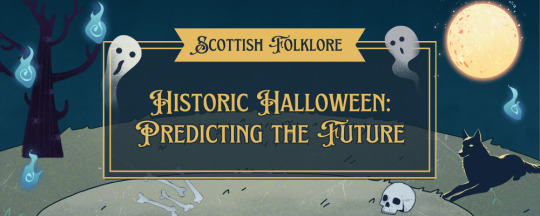
"Love charms, indeed, form an important group of wishing superstitions. To this class belong Hallow E’en rites, such as eating an apple before a mirror, and sowing hemp seed."
“Folklore of Scottish Lochs and Springs” by James M MacKinlay (1893)
While it might seem strange now, predicting the future was once an important part of Halloween festivities. In fact, it was a tradition that was absolutely expected at gatherings.
"As the evening wore on, the young people gathered to one house, and an almost endless variety of games (cleasan) were resorted to, with the object in every case of divining the future lot of the company."
“Witchcraft & Second Sight in The Highlands and Islands of Scotland” by John Gregorson Campbell (1902)

Some of these even carried over to America, such as the tradition of bobbing for apples (dooking for apples). While very much so also a game, the reason for it was to foretell who would have the best luck.
"Apples and a silver sixpence were put in a tub of water. The apples floated on the top, but the coin lay close to the bottom. Whoever was able to lift either in his mouth, and without using his teeth, was counted very lucky, and got the prize to himself."
“Witchcraft & Second Sight in The Highlands and Islands of Scotland” by John Gregorson Campbell (1902)
Other traditions might not be recognizable now, but were done with much laughter and teasing.
"A dish of milk and meal (fuarag, Scot. crowdie), or of beat potatoes, was made, and a ring was concealed in it. Spoons were given to the company, and a vigorous attack was made on the dish. Whoever got the ring would prove to be the first married. This was an excellent way of making the taking of food part of the evening’s merriment."
“Witchcraft & Second Sight in The Highlands and Islands of Scotland” by John Gregorson Campbell (1902)
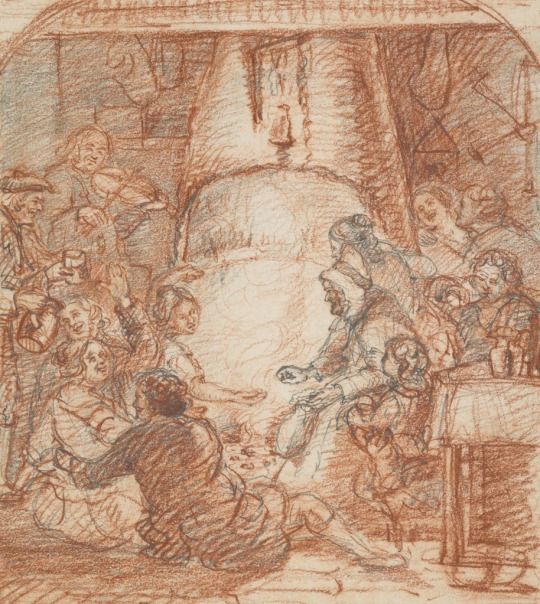
There were many different customs to predict the future, and some were designed to be done with the group.
Burning the Nut:
Amongst the spells practiced inside the house was burning the nuts. As the company sat around the fireside, they named a lad or lass to each nut as it was laid on the fire, and according to the behavior of the nuts, so would the course and issue of the courtship be."
“Primitive Beliefs in the North-East of Scotland” by Joseph McKenzie McPherson (1929)
While others were specifically for a girl to sneak away and perform while alone.
Sowing Lint-seed:
"When the shades of evening were falling, the maiden had to steal out quietly with a handful of lint-seed, and walk across the ridges of a field, sowing the seed, and repeating the words: “Lint-seed I saw ye, Lint-seed I saw ye; Lat him it’s to be my lad Come after me, and pu’ me.” On looking over the left shoulder she saw the apparition of him who was to be her mate crossing the ridges, as it were, in the act of pulling flax.”
“Folklore of the North East of Scotland” by Walter Gregor (1881)
All in all, these “future telling” customs were a fun way to tease friends or family, or a way to (maybe) secretly see something that would make you hopeful for the future.
Historic Audio Recordings:
(link) 1974 — A Halloween divination custom.
(link) 1978 — Halloween divination; an instance when it came true.
(link) 1977 — Orkney Halloween customs, including divination; tricks at Halloween and other times
#samhuinn#samhain#halloween#scotland#scottish#scottish mythology#scottish folklore#scottishfolklore#ImportantScottishDays#history#witchblr#folklore#mythology#myths#witchcraft#future teller#future telling#divination#apple bobbing
9 notes
·
View notes
Text

Historic Halloween: Costumes, Fairs, and Fancy Balls
Halloween was once a much bigger festival than it is now, but some of its traditions still carry on. Today, when people think Halloween, the first thought might be “costumes,” and costumes are not a new addition.
"The Hallowe’en guisers were formerly found all over the country from Holyrood, where their appearance at the Court on ‘Aphallowday, 1585, is recorded, to the remotest Isles."
“Silver Bough: Volume 3” by by F. Marian McNeil

It is thought that the tradition came to be from people dressing up in frightening attire to avoid the mischief of the spirits of the dead roaming around. Depending on where you were, this might be known as “mumming,” “guising,” or “going galoshins.”
This was a tradition that continued on into the form of Halloween fairs, parades, and balls.
"Up until 1925, the celebration of Hallowe’en in Brechin was a notable occasion, when large numbers of people, old and young, in a variety of fantastic costumes or disguises, paraded the main streets, which were lined with spectators. After the parade, which lasted for about two hours, thus taking part attended a Hallowe’en Carnival Ball."
"Folklore of Lowland Scotland" by Eve Blantyre Simpson (1908)
Even the tradition of trick-or-treating is said to come from the tradition of soul caking which dates to medieval times in England. During this, both children and the poor would go door-to-door singing and saying prayers in exchange for the small round cakes.

There is a song from The Watersons in 1965 that immortalizes this in the lyrics of ” Souling Song.” You can listen to it on YouTube here.
There is also a recipe you can try on this website.
For the fairs, they occurred in many places. The original site for the one in Edinburgh was Calton Hill.
"In the Edinburgh Charters (1507), reference is made to the ‘Alhalow Fair quhilk (which) is haldin at our burgh of Edinburgh,’ and a notice appeared annually in the old Edinburgh Evening Courant that ‘A11-Hallow Fair of this city is to be kept on the twelfth day of November (Hallowe’en, O.S.), to continue the usual time, and to be: kept and held on the lands of Caltonhill.’ Later it moved to the Grassmarket."
“Silver Bough: Volume 3” by by F. Marian McNeil

HISTORIC AUDIO RECORDINGS
(link) Halloween; guising; harvest customs, including straw dogs; profit-taking. 1970
(link) Guising at Halloween. 1982
(link) GALOSHINS
#samhuinn#samhain#scotland#scottish mythology#scottish folklore#scottishfolklore#scottish#myths#mythology#halloween#ImportantScottishDays
11 notes
·
View notes
Text
Isle of Lewis Sea God: Shony
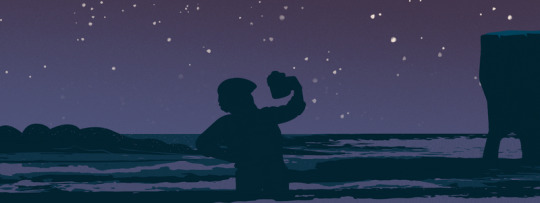
On the Isle of Lewis, there was once custom of giving offerings to a sea god named Seonaidh, which is anglicized to Shony.
“Shony was a sea-god in Lewis, where ale was sacrificed to him at Hallowtide. ”
The Norse Influence on Celtic Scotland by Dr. George Henderson(1901)
The people there would collectively provide ingredients for the ale that would be brewed at the church, then a person would wade out into the sea on Halloween night and give a cupful of ale to the sea as an offering to Shony.
"Ale was brewed at church from malt brought collectively by the people. One took a cupful in his hand, and waded out into the sea up to his waist, saying as he poured it out: “Shony, I give you this cup of ale, hoping that you’ll be so kind as to send us plenty of sea-ware, for enriching our ground the ensuing year.” The party returned to the church, waited for a given signal when a candle burning on the altar was blown out. Then they went out into the fields, and drank ale with dance and song."
The Book of Hallowe’en by RUTH EDNA KELLEY, A. M. (1919)
The practice was eventually snuffed out by the church, but Shony is still a topic of Scottish folklore to this day.
"The history of superstition teaches us with what persistence pagan beliefs hold their ground in the midst of a Christian civilisation. Martin, who visited the Western Islands at the close of the seventeenth century, found how true this was in many details of daily life. A custom connected with ancient sea-worship had been popular among the inhabitants of Lewis till about thirty-years before his visit, but had been suppressed by the Protestant clergy on account of its pagan character."
Folklore of Scottish Lochs and Springs by James M. Mackinlay (1893)
#shony#ScottishPaganism#scottish pagan#scottish history#gods of scotland#Seonaidh#Scottish folklore#ScottishFolklore#scottish mythology#scottishmythology#halloween#Scottish gods#scottishgods#scottishpagan#scottish paganism#samhain#samhuinn#ImportantScottishDays#TheOldGods
15 notes
·
View notes
Text
Historical Hogmanay (Scottish New Year)

Hogmanay is the name for the Scottish New Year Eve, and was once thought to be a time when the veil was thin, allowing all sorts of creatures from the Otherworld into ours. Some theorize that this supernatural aspect is even where the name came from.
“We know that on this night it was considered necessary to propitiate the dwellers in fairy-land, who, with the Phynnodderees, Witches, and Spirits of all kinds, were abroad and especially powerful. We may, therefore, perhaps translate Hog-man-aye into Hanga-man-ey–“mound-men (for) ever,” the Fairies being considered as dwellers in the hows (or tumuli, or green mounds)…-“
The Folk-Lore of the Isle of Man by A. W. Moore[1891]
The pagan roots of the festival were once clear, and some locations held onto those traditions longer than others. For example, the Isle of Man once had a person puppet a horses head made of wood that was called White Mare.
“He went round the table snapping the horse’s mouth at the guests who finally chased him from the room, after much rough play.”
The Folk-Lore of the Isle of Man by A. W. Moore[1891]
Similarly, some places in Scotland had a person in a cows hide who would be chased around the house by people with sticks.
“Each then pulled off a piece of the hide, and burnt it for the purpose of driving away disease.”
The Folk-Lore of the Isle of Man by A. W. Moore[1891]
Many of the traditions have died out, while others might still seem familiar.
Fires
For some on the last day of the year, the fire was to be smothered and made smooth. First thing in the morning, you would look for prints in the ash.
“The first thing on New Year’s morning was to examine if there was in the ashes any mark like the shape of a human foot with the toes pointing towards the door. If there was such a mark, one was to be removed from the family before the year was run. Some climbed to the roof of the house and looked down the “lum” for the dreaded mark.”
Notes on Folk-Lore of the North-East of Scotland by Walter Gregor, M.A. (1881)
For others, the fire was not allowed to go out all night.
"It was a practice not to be neglected to keep the fire alive in the house all night. No one was to come near it but a friend, and, as an additional security against its going out, candles were kept burning. Hence, the other name given to the night, Oidhche Choinnle, i.e. candle night."
Witchcraft & Second Sight in the Highlands & Islands of Scotland by John Gregorson Campbell (1902)
If the fire did go out, you would be on your own. It was considered unlucky to give out fire on the first day of the year, so your neighbors would be unlikely to assist.
“It gave the means to witches and evilly-disposed people to do irreparable mischief to the cattle and their produce. The dying out of the fire was, therefore, a serious inconvenience in days when lucifer matches were unknown.”
Witchcraft & Second Sight in the Highlands & Islands of Scotland by John Gregorson Campbell (1902)
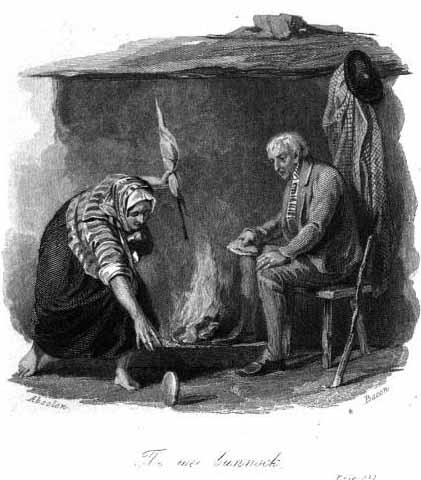
Juniper Saining
“On New Year’s day the Highlanders burned juniper before their cattle.”
Old Scottish Customs, Local and General by Ellen Emma Guthrie 1885
Saining is a set of practices to cleanse or ward off evil, and juniper smoke is one example of it. Saining could be done at any time of year, but it was though to be stronger during times when the veil was thin.
Every room was cleansed with the smoke, and so were humans and cattle.
“Stewart in his “Popular Superstitions of the Highlands of Scotland” tells how on the last night of the year the Strathdown Highlanders used to bring home great loads of juniper, which on New Year’s Day was kindled in the different rooms, all apertures being closed so that the smoke might produce a thorough fumigation.
Not only human beings had to stand this, but horses and other animals were treated in the same way to preserve them from harm throughout the year. Moreover, first thing on New Year’s morning, everybody, while still in bed, was asperged with a large brush.”
Christmas in Ritual and Tradition, by Clement A. Miles, [1912]
Mumming
Mumming or guising is something people tend to associate with Halloween (trick-or-treating), but it also happened on Christmas and Hogmanay. Mummers (commonly poor folk) would entertain in exchange for food and drink.
Here is an example of just one rhyme:
“Get up, goodwife, and shake your feathers,
And dinna think that we are beggars;
For we are bairns come out to play,
Get up and gie’s our hogmanay!”
Christmas in Ritual and Tradition, by Clement A. Miles, [1912]
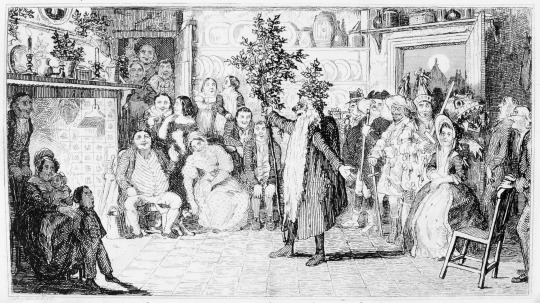
Drinking
This is something people will recognize; drinking. People would get together with food and drinks (typically het pint).
“On the approach of twelve o’clock, a hot pint was prepared—that is, a kettle or flagon full of warm, spiced, and sweetened ale, with an infusion of spirits.
When the clock had struck the knell of the departed year, each member of the family drank of this mixture ‘A good health and a happy New Year and many of them’ to all the rest, with a general hand-shaking.”
Christmas in Ritual and Tradition, by Clement A. Miles, [1912]
When midnight hit, you would share with neighbors.
"Even the poorest in Scotland exchange sips of hot spiced ale, and make offerings of cakes, buns, and shortbread to their neighbours when ushering in the New Year on the stroke of midnight."
Manners, Customs, and Observances: Their Origin and Significance by Leopold Wagner[1894]

First Footing
Who was first to enter your home on the new year could alter your luck for the year.
“The first-footers are off and away, flying in every direction through the city, singing, cheering, and shaking hands with all and sundry.”
Christmas in Ritual and Tradition, by Clement A. Miles, [1912]
For many places, you would hope it to be a dark-haired man.

#hogmany#hogmanay#new year#new years#scottish#scotland#scottish new year#new year scotland#pagan#paganism#scottish paganism#scottishpaganism#historic#history#historical#Festivals#PaganScotland#pagan scotland#scottishpagan#ImportantScottishDays
31 notes
·
View notes
Text
Traditional Ways to Celebrate a Scottish Yule/Christmas

In this post I want to talk about traditional Yule practices in Scotland, but it may be noticed that there is little to no talk about going to church at all. This is not an intentional slight against the church, but simply that my sources don’t tend to mention it as part of the celebrations. Instead, most the traditions mention time with family and friends, as much and as grand of food as one could afford, and traditions to fight darkness/evil spirits.
All that may seem strange, but many of the traditions we do today were also done in Scotland. For example, the very idea of the Christmas Card is said to have been invented in Edinburgh.
"The idea of the greetings card was proposed to Mr. Drummond by an Edinburgh friend, Mr. Thomas Sturrock of Trinity, and the engraving was made by Mr. A. T. Aikman. It was the face of a cubby-cheeked boy with twinkling eyes, his face crinkled with laughter."
Silver Bough: Vol 3 by F. Marian McNeill
Other traditions will be certainly less recognizable.
If you want to know about the basics of a Scottish historical Yule first, I have a post on that as well.

1. BREAKFAST
Today, some people have a tradition of a big breakfast on Christmas/Yule day, and that is not a new custom.
"The breakfast on Christmas morning was the best that could be afforded–milk porridge, creamy milk, butter, fish, ect."
Notes on The Folk-Lore of the North-East of Scotland By Walter Gregor [1881]
Some people would have mutton, beef, or goose, while others ate a customary dish. People would typically just eat what they could afford, but a common dish was Sowens.
“The other was a cake the leaven of which had been moistened with water poured off “sowens,” which gave it a peculiar acid flavour. It was essential that both these kinds of cake should be baked during the night—at any rate, before daybreak on Christmas morning.”
A History of Moray and Nairn by Charles J. Rampini (1897)
The women of the house would typically make it without any men around, then distribute it to the household while they were in bed (breakfast in bed).
Nine o’clock was an orthodox hour in Carglen , and at nine o’clock it was the orthodox rule to retire to rest , even on the eve of Yule . That is to say , the men folks retired ; the women were busy with the “ sowens ” -mysterious decoction ! So we all went to bed till midnight , and at the mystic hour of twelve the female folks awoke us , and deluged our stomachs till they could hold no more with the sweet , vile “ sowens . ”
The Folks O’ Carglen, Or, Life in the North Book by Alexander Gordon (1891)

2. FIRST-FOOTING
Just like on Hogmanay, some places practiced “first footing,” where it was considered lucky if a dark haired person was first to enter.
To start, a person would open the door, and be lucky for doing so. This was called “letting in Yule.”
"In some parts of Scotland , he who first opens the door on Yule Day expects to prosper more than any other member of the family during the future year because , as the vulgar express it , “ He lets in yule . "
”British Popular Customs, Present and Past; Illustrating the Social and Domestic by T. F. Thiselton-Dyer (1848-1923)
Then comes the superstition regarding hair. If the first person to enter your home had dark hair, that was also lucky.

3. NEW CLOTHES
It was often considered necessary to wear new clothes on Christmas day, and those without it would be rudely ridiculed.
Every means was used to have some piece of new dress, no matter how small. The one who was so unfortunate as to be without such a piece of dress bore the name of “Yeel’s jaad.
Notes on The Folk-Lore of the North-East of Scotland By Walter Gregor [1881]

4. DANCING
Balls were one way to celebrate, and some were so much fun, that they could go on until daylight. Most commonly, these were held in barns.
"Balls were among the amusements of the season. A barn, conveniently situated for the district and sufficiently large, was selected. It was swept as clean as possible, and filled up with seats round the wall–deals supported on all manner of supports–stones, turf, cart-wheel bushes, bags filled with grain, &c. A plentiful supply of eaten cakes, biscuits, cheese, fish, ale, porter, whisky, and sugar for the toddy, was got, and committed to the care, of a few of the “hehds o’ the ball.”
Notes on The Folk-Lore of the North-East of Scotland By Walter Gregor [1881]

5. GAMES
After breakfast, games would be played. This could be anything from Shinty, to a shooting contest, to some other type of game.
"As the day advances , those minor amusements are terminated at the report of the gun , or the rattle of the ball – clubs – the gun inviting the marksman to the ” Kiavamuchd , ” or prize – shoot ing , and the latter to ” Luchd – vouil , ” or the ball combatants – both the principal sports of the day ."
The Popular Superstitions and Festive Amusements of the Highlanders of Scotland by William Grant Stewart (1823)

6. SAINING
Saining is the process of cleansing something or bestowing protection from the powers of evil. These could fight fairies, witchcraft, the evil eye, or bad luck.
On the 24th, fairies and trows in particular were said to be out in full force, so extra protection was in order.
In the case of Christmas, Juniper smoke may be used.
"A fire was kindled in each byre on Christmas morning, and in parts of the country the byres were purified by burning juniper in them."
Notes on The Folk-Lore of the North-East of Scotland By Walter Gregor [1881]
As well as that, if you did not want something to go missing, it was recommended to put it away.

7. DINNER
Dinner traditions would change depending on your wealth and location.
"To have flesh for the Yeel dinner great exertion was made, as it was thought that the cattle would not thrive during the year if it was awanting. It was a custom not to sit down to the great dinner of the year till after sunset. The Yeel kebback was cut by the gueedeman. During the whole time of Yeel the diet was more generous than at other times."
Notes on The Folk-Lore of the North-East of Scotland By Walter Gregor [1881]
Sometimes, the main dish would be dumplings or fish.
“Yeel” fish was bought. Sometimes this was done from fisherwomen who carried them over the country. Sometimes those in better circumstances went to the fishing villages, and bought the fish from the boat, carried them home, cured them, and smoked them on the kiln.
Notes on The Folk-Lore of the North-East of Scotland By Walter Gregor [1881]
Even the cattle and sheep would get extra sheaf on Yule and New Year.

8. STORIES
Stories were a must, and sometimes that involved heading out to collect a good (old) storyteller.
This errand , on which we suppose the gude man and his assistants employed , is the procuring of Calluch Nollic , or Christmas Old Wife , an indispensable requisite for this occasion , and it will perhaps puzzle some of our readers , to guess the purpose for which the good woman is wanted .
The Popular Superstitions and Festive Amusements of the Highlanders of Scotland by William Grant Stewart (1823)
Interestingly, other places had story traditions as well. For example, ghost stories were a common Christmas pass-time for the Victorians.
#scottish christmas#scottishchristmas#scottishyule#yule#yuletime#yuletide#history#historic#christmas#scotland#PaganScotland#Festivals#ImportantScottishDays
23 notes
·
View notes
Text
Historical Scottish Christmas/Yule Basics

Scotland actually has a relatively short history with Christmas as we would typically think of it compared to other places, namely because it was illegal to celebrate it for a long time.
“Before the Reformation in 1560, Christmas in Scotland had been a religious feasting day. Then, with the powerful Kirk frowning upon anything related to Roman Catholicism, the Scottish Parliament passed a law in 1640 that made celebrating ‘Yule vacations’ illegal.”
National Trust For Scotland
Christmas did not become a public holiday in Scotland until 1958. That does not mean that nothing was celebrated prior to that, but if or if not the laws were enforced depended on where you lived.
Many farming communities kept up traditions for a long time even though it was illegal, while other communities moved many of them to Hogmanay.
One thing you will notice while reading historical traditions in Scotland is that instead of Christmas, many people called it “Yule.” The word Yule (which has several alternative spellings) and many of the customs for it were brought over to Scotland by the Norse. Even after the church had firmly settled into Scotland, calling it “Yule” continued for much of Scottish history.
“Every time they are mentioned [in the church-records] it is in connection with some superstitious observances at Yuletide. On one occasion we find John Stewart, Andrew Robertson, and various others, charged with being “ down on the linkcs ” at Yule and charged ” not to do the like again.” One could wish that the Minute had been fuller on such an occasion.
“Examples of Printed Folk-lore Concerning Fife: With Some Notes on Clackmannan and Kinross-shires by John Ewart Simpkins (1914)
It is perhaps no surprise that many of the traditions are thought to come from the origins of Yule. For example, Yule logs were very popular; which, by the way, is an actual log, not a dessert. However, wood was expensive and not always easy to get, leading to many people replaced the log with a candle.
In England the Yule log was often supplemented or replaced by a great candle. At Ripon in the eighteenth century the chandlers sent their customers large candles on Christmas Eve, and the coopers, logs of wood. 11-26 Hampson, writing in 1841, says:—
“In some places candles are made of a particular kind, because the candle that is lighted on Christmas Day must be so large as to burn from the time of its ignition to the close of the day, otherwise it will portend evil to the family for the ensuing year.”
Credited to w11-26 Hampson, writing in 1841. In the book Christmas in Ritual and Tradition, by Clement A. Miles, [1912]
Yule was not the only other word used in Scotland, either. There was also Nollaig. This word described the celebrations lasting from around Christmas to new year.
There was also:
Oidhche nam bannagan (the night of Cakes) Christmas Eve
Latha Nollaig mhór (the day of big Nollaig): Christmas Day
Oidhche nan Calluinnean (the night of blows): New Years Eve
Latha Nollaig bhig (the day of little Nollaig): New Years Day

As well as the Nordic yule influence, the Roman festival of Saturnella is also thought to have had an influence on the bringing in of evergreen boughs (garland). For Saturnella, Priests obliged people to bring in boughs and springs of evergreens.
Then, of course, there is the influence of more local paganism, such as for mistletoe. In fact, mistletoe was once thought of as such a pagan thing, that it was not welcome everywhere. Despite that, it became a common decoration.
Brand ( Popular Antiquities 1819 , vol . 1 . p . 523 ) thinks that mistletoe was never put in churches among ever greens but by mistake or ignorance ; for , says he , it was the heathenish , or profane plant , as having been of such distinction in the pagan rites of druidism , and it had its place therefore assigned it in kitchens , where it was hung in great state
British Popular Customs, Present and Past; Illustrating the Social and Domestic by T. F. Thistelton Dyer

Christmas, Yule, Latha Nollaig mhór, or whatever else it may be called, was a big celebration that pretty well stretched from then, to Hogmanay.
Since it was such a big event, people did everything they could to finish their work before Yule, and they would try to not take new work in the span between the two celebrations.
Today, most people do call it Christmas, and celebrate it in a way that would me more similar to other countries.

Note: all citations are on my website post here.
#christmas#yule#scottishchristmas#scottish christmas#historical#history#historical christmas#scottish paganism#yuletime#PaganScotland#Festivals#ImportantScottishDays
14 notes
·
View notes
Text
The Importance of Quarter Days
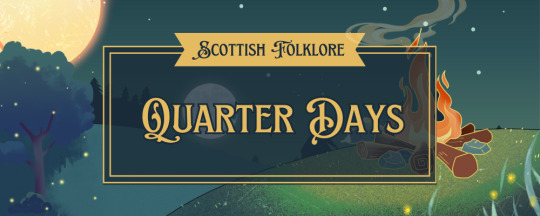
Historically, the most important festivals in Scotland were held on quarter days. These days roughly marked the mid-points between the solstices and equinoxes.
For example, Samhuinn(which later became Hallowmas or Hallowe’en), sits approximately midway between the autumn equinox and winter solstice. The other important days were Oimelc or Imbolic (St. Bride’s Day), Bealltan (Beltane or May Day), and Lugnassad (Lammas).
During these days, the veil between our world and the other world was said to be at it’s thinnest (though even more so for Samhuinn). On the eve of them, fairies are said to race between fairy mounds. On the quarter day is when the power of magical rites would be strongest.
While it may seem like witchcraft now, rites preformed during quarter days were often done for the purpose of keeping away evil spirts, fairies, and witchcraft. These acts are also called “Saining.” Saining is both a practice to bestow protection on an object, person, or animal, and also a way to cleanse something. It is not a practice restricted to a quarter day, it is simply that the practice was said to be at its strongest on those days.
“The fair folk” were most covetous of new-born children and their mothers. Till the mothers were “sained” and churched, and the children were baptized, the most strict watch and ward had to be kept over them to keep them from being stolen."
Folklore of the North East of Scotland by Walter Gregor (1881)
There are practices that were for specific quarter days, but also some that were common to all. For example, a farmer might try to steal a farmers success by collecting dew from that farmers field, while that successful farmer might get up before sunrise to have their animals drink silvered water (water with a silver coin) to protect the animals from the before mentioned act and evil.
Another common theme was the need-fire. This fire is why these quarter days are also often called “fire festivals.” People would put out the fire in their houses, then one would be created with friction between two sticks.
"The ritual kindling of the need-fire was one of the main ceremonies at the great fire-festivals. It was the most potent of all charms to circumvent the powers of darkness, and was resorted torn any immanent or actual calamity, or to ensure success in any important undertaking."
The Silver Bough: Volume 1 by F. Marian McNeill (1957-1968)
None of these were seen as witchcraft, but rather as protection from it and other evils.
Another important part of all the quarter days were Quarter Cakes. These cakes were a type of bannock(often made with oatmeal), and while bannock could be eaten on any day, Quarter Cakes were made specifically for the quarter day in mind.
Most commonly, they were made with oatmeal, but that could be because it was more commonly available than wheat flour was.
“The baking is executed by women only, and they seldom began their work till after sunset, and a night or two before the fair. A large space of the house, chosen for the purpose, is marked out by a line drawn upon it. The area within it is considered as consecrated ground; and is not by any of the by-standers to be touched with impunity. “
McNeill, The Silver Bough Volume 3, 1961
The making of them were often made into a loud and fun task.
"As the baking is wholly performed by the hand, a great deal of noise is the consequence. The beats, however, are not irregular nor destitute of an agreeable harmony; especially when they are accompanied with vocal music, which is frequently the case. "
McNeill, The Silver Bough Volume 3, 1961
These songs were likely what was called Waulking songs. These songs were most common while beating newly woven tweed or tartan to lightly felt it and shrink it to better repel water, because the songs would keep the women working in beat, so everyone was synchronized in their work.
One large cake was made for the whole family, as well as smaller ones for each individual person. While eating them, they would alternate throwing pieces over their shoulders
‘Here to thee wolf, spare my sheep; there to thee fox, spare my lambs; here to thee eagle, spare my goats; there to thee raven, spare my kids; here to thee martin, spare my fowls; there to thee harrier, spare my chickens.”
The Silver Bough: Volume 1 by F. Marian McNeill (1957-1968)
7 notes
·
View notes
Text
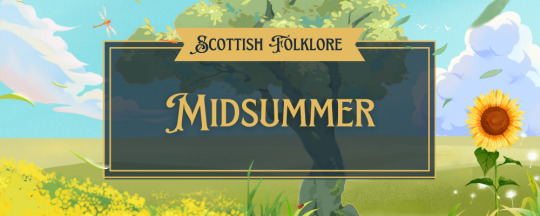
While not as popular to celebrate today, Midsummer was once an important celebration in Scotland.
The day was eventually renamed “St. John's Day” by the church and major attempts were made to remove the old traditions associated with Midsummer.
Many of the old traditions involved using the purifying nature of fire, so a statute was enacted in 1581 forbidding the practice. Much to the annoyance of authorities at the time, even that did not stop the fires completely.
"...and in 1665, the Presbytery of Dingwall ordained that their congregations should be abjured to 'desist from the superstitious abuses used on St. John's Day by burning torches through their cornes and fires in their towns, and thereafter fixing their stakes in their kail-yards."
The Silver Bough Vol 2 by F. Marian McNeill
How the fire was used could change slightly depending on the place. Some would light a fire by their door, while others would carry torches around their properties or light fires in a location that ensured the smoke would carry over their fields.
"On Midsummer Eve people in the Isle of Man were wont to light fires to the windward of every field, so that the smoke might pass over the corn; and they folded their cattle and carried blazing furze or gorse round them several times."
The Golden Bough by Sir James George Frazer [1922]
Since the veil between our world and the Otherworld was thought to be thin at this time, that meant not only where more fairies around, but also that the magical protective properties of plants were at their strongest.
Birch branches might be hung over a door for protection, alongside elderberries and St. John's Wort.
"On Midsummer Eve, when their power is at its height, flowers and herbs are the only barriers to their incursions, and these are regularly spread at the doors of the houses to protect the inmates."
The Folk-Lore of the Isle of Man by A. W. Moore[1891]
One of the strangest things folklore said you could gather are fern seeds, but you only have one night to do it. According to science, ferns spread through spores, but according to folklore, you can collect fern seeds on midsummer eve. Collecting them was a dangerous act since they were protected by fairies, but getting fern seeds could give you the ability to turn invisible.
Other common traditions are fortune-telling, collecting morning dew, feasts, dances, and weddings or betrothals.

"Midsummer Eve" by Edward Robert Hughes (1908)
Want more research and citations? I have a longer list on my website (scroll to the bottom of the post).
#folklore#scottish folklore#scottish mythology#midsummer#midsummer eve#scottishfolklore#scottish#fairies#fairy#fae#scotland#mythology#summer solstice#myths#grimiore#pagan#paganism#scottish paganism#ImportantScottishDays
4 notes
·
View notes
Text
Serpent Day 🐍 and Imbolc Facts
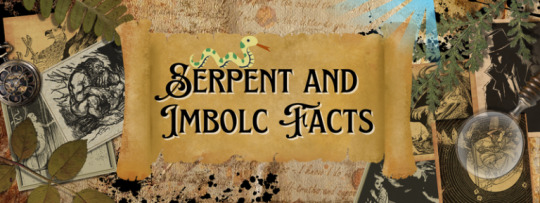
According to Days of the Year, today is Serpent Day, which aims to raise knowledge on serpents; including their place in history, and it's current cultural influence around the world. This is particularly good timing for Celtic folklore, since there is serpent lore directly related to today.
To start, this is going to take some background details on the Celtic signifigence of the festival which (now) takes place on Feburary 1st.
Imbolc was one of the four main Celtic seasonal festivals, and just like Samhain/Halloween, it is a cross-quarter day(approximately halfway between a solstice and equinox).
"Four days on the Celtic calendar were occasions for mainline festivals: Samain (November), Imbolc (February), Beltaine (May), and Lughnasa (August)."
A Dictionary of Celtic Mythology
Because of this importance, many ancient monuments(such as the Hill of Tara) were approximately aligned with their openings faced towards the sunrise of those days.
The time itself was a festival dedicated women, fertility, and milk, and is heavily associated with two different women, both named Brigid.
The first Brigid is the oldest, and is a pre-Christian goddess of fire, blacksmithing, fertility, cattle, crops, and poetry.
It is even thought by some that the traditions of the North American Groundhog Day (February second) may actually come from a Manx superstition for the day.

The second Brigid is the one Bride's Day currently celebrates, and that is St. Brigid. In Kildare (Irish) lore, she started as a slave, but through a good heart and miracles, she eventually found a path that lead her to founding a convent and a monastery.
Perhaps as a form of syncretism, St. Brigid was declared the saint of many things...including blacksmithing, livestock, dairy production, and poetry. Many aspects of the goddess Brigid, including some stories, became associated instead with the Saint.
All of those are the trails that lead to modern day St Bride's Day, which replaced Imbolc and only focused on St. Brigid.
"On "Bride's Day", the first day of the Gaelic Spring, offerings were made to earth and sea. Milk was poured on the ground, and the fisher people made porridge and threw it into the sea so that the sea might yield what was sought from it—lots of fish, and also seaweed for fertilizing the soil. "
"Wonder Tales from Scottish Myth and Legend" By Donald A MacKenzie (1917)
Backstory finished, on to the serpent lore I promised.
On St. Bride's Day, "the serpent" is supposed to emerge. This is showcased in a hymn associated for the day.
“Early on Bride's morn, The serpent shall come ft-om the hole, I will not molest the serpent, Nor will the serpent molest me." "Carmina Gadelica:"
Vol 1, p. 169 by Alexander Carmicheal, (1900)
There is a similar but slightly different version in "Wonder Tales from Scottish Myth and Legend" By Donald A MacKenzie (1917).
"Another sacred animal was the serpent. All winter long it slept secure from storms and cold. When, however, Beira, the winter goddess, was overthrown, and Bride, the goddess of growth, began her reign, the serpent came forth from its winter abode. The people then chanted a hymn, of which the following is a verse:-
To-day is the Day of Bride,
The serpent shall come from his hole,
I will not molest the serpent,
And the serpent will not molest me.
The serpent was sometimes called "Daughter of Ivor", and MacIvors were supposed to be safe from attack by her and all other serpents. She was also referred to as "noble queen". It is possible she was a form of the Earth spirit in spring-time."
Wonder Tales from Scottish Myth and Legend" By Donald A MacKenzie (1917)
MacKenzie also mentioned that a white serpent was supposed to give skill to physicians. All it took was cooking a specific part of the body, and the first person who tasted it would obtain the healing powers.
1 note
·
View note
Text
Traditional Hogmanay Drink: The Het-Pint

The first recorded mention of the Het-Pint was in the Burgh records of 1662. It was a very popular drink, and it was customary to serve it or cider to the Hogmanay guisers.
“Liberal libations of cider , or egg – hot , that is , cider heated and mixed with eggs and spices , somewhat after the manner of the Scottish het – pint , are supplied to the assembled revellers , …"
"The Book of Days: Volume 2" by Robert Chambers 1832
It was such a staple that Scottish travelers would mention how strange it was to them to not have it during celebrations.
“He said it was uncanny , and would certainly have felt it very uncomfortable , not to welcome the new year in the midst of his family and a few old friends , with the immemorial libation of a het pint . ”
Accredited to Lockhart’s Life of Scott (1819) in Faiths and Folklore: Volume 2 by William Carew Hazlitt (1905)
HET PINT RECIPE
This recipe is from Electric Scotland
INGREDIENTS:
4 pt mild ale
1 tsp nutmeg
4 oz sugar
3 eggs
1/2 pint of Whisky
DIRECTIONS
Put the ale into a thick saucepan, then add the nutmeg, and bring to just below boiling point. ( If it boils, the alcoholic content is considerably lowered. )
Stir in the sugar and let it dissolve.
Beat the eggs very well, and add them gradually to the beer, stirring all the time so that it doesn’t curdle.
Then add the Whisky , and heat up, but on no account boil.
Pour the liquid from the saucepan into heated tankards, back and forth so that it becomes clear and sparkling.
___
"This beverage , carried about in a bright copper kettle , is , or was , the celebrated New – Year’s – Morning Het Pint of Edinburgh and Glasgow ."
The Cook and Housewife’s Manual by Margaret Dods(1826)
Personally, I am not a fan of ale (though the whisky can stay). Instead, it looks like the recipe for Auld Man’s Milk (Old Man’s Milk) is sadly more to my tastes. Uh oh, I guess I am old now.
___
AULD MAN’S MILK RECIPE
This recipe is from The Cook and Housewife’s Manual by Margaret Dods(1826).
INGREDIENTS:
Milk or Cream
Rum, Whisky, or Brandy
Eggs
Nutmeg or Lemon Zest
DIRECTIONS
Beat the yolks and whites of six eggs separately.
Put to the beat yolks sugar and a quart of new milk or thin sweet cream.
Add to this rum, whisky, or brandy to taste (about a half-pint).
Slip in the whipt whites, and give the whole a gentle stir up in the china punch-bowl, in which it should be mixed.
It may be flavoured with nutmeg or lemon zest.
#christmas#recipe#yule#yuletide#scotland#scottish#scottish new years#hogmanay#new year#new years#recipes#history#Festivals#ImportantScottishDays
0 notes